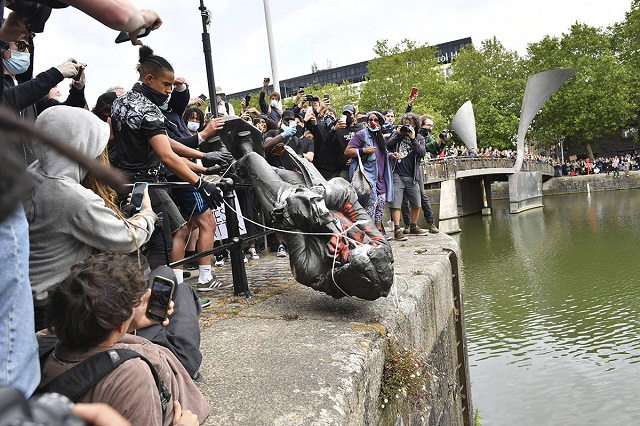
London, United Kingdom | AFP | British politicians on Monday condemned the destruction of a statue to a leading slave trader during an anti-racism protest, but a leading heritage body said there was no need to reinstate it.
Demonstrators pulled down the 18-foot (5.5-metre) bronze monument to Edward Colston in the southwest English city of Bristol and threw it into the harbour on Sunday.
The protest was one of many across Britain in recent days in response to the death of George Floyd, an unarmed black man, at the hands of police in the United States.
Most marches were peaceful but there were flashes of violence, including in London, where the statue of World War II leader Winston Churchill in Parliament Square was defaced.
Prime Minister Boris Johnson condemned the clashes as “a betrayal of the cause they purport to serve”.
Home Secretary Priti Patel said the toppling of the Bristol statue was “utterly disgraceful” and one of her ministers, Kit Malthouse, said charges should be brought.
“A crime was committed, criminal damage was committed, there should be evidence gathered and a prosecution should follow,” he told the BBC on Monday.
Keir Starmer, the leader of the main opposition Labour party, said it was “completely wrong” to pull down the statue in that way.
But he said that in view of Colston’s role as a top official in the Royal African Company in the late 17th century, it should have been removed “a long time ago” and put in a museum.
“This was a man who was responsible for 100,000 people being moved from Africa to the Caribbean as slaves, including women and children who were branded on their chests with the name of the company he ran,” he told LBC radio.
Colston, who came from a wealthy merchant family, was also a member of parliament and philanthropist, donating huge funds to support schools, hospitals, almshouses and churches.
– Symbol of pain –
Marvin Rees, Bristol’s elected Labour mayor, said he believed the statue would end up in a museum, alongside banners from Sunday’s Black Lives Matter protest.
Rees, who is of Jamaican heritage, said he “cannot condone the damage” but described the destruction of the statue as an “iconic moment”.
“I cannot pretend it was anything other than a personal affront to me to have it in the middle of Bristol, the city in which I grew up,” he told BBC radio.
Historic England, a government heritage body, said the local community must now decide what to do with the statue but “we do not believe it must be reinstated.”
“Edward Colston’s statue in Bristol has long been the focus of debate due to his involvement in the slave trade,” it said.
“We recognise that the statue was a symbol of injustice and a source of great pain for many people.”
Many buildings and streets in Bristol still bear Colston’s name but pressure has mounted on local authorities in recent decades to address his legacy.
Authorities had agreed to rename his statue, which was erected in 1895, to highlight his role in slavery but the process became deadlocked because of conflicting views.
– ‘Who we are’ –
Institutions and local authorities across Britain have in recent years been re-examining their public monuments in the face of demands to better represent the country’s colonial past.
Oxford University saw an angry but unsuccessful campaign to remove a statue of 19th-century British imperialist Cecil Rhodes, and debate over its future still rages.
Students at Jesus College, Cambridge, successfully fought for the return of a bronze cockerel looted by British colonial forces in the 19th century to Nigeria.
“No debate about the way we run our public spaces should ever be finished,” Mayor Rees said.
“We should be constantly wrestling with who we are and where we’ve come from.”
 The Independent Uganda: You get the Truth we Pay the Price
The Independent Uganda: You get the Truth we Pay the Price



